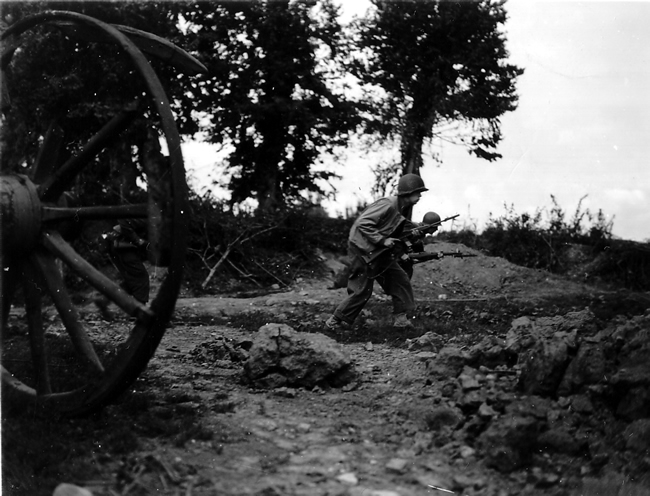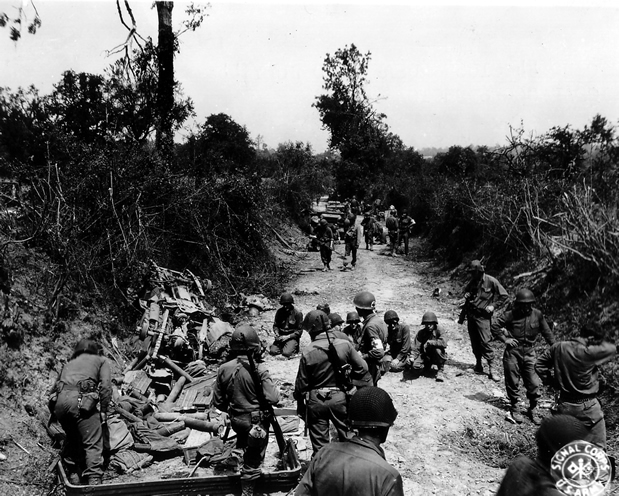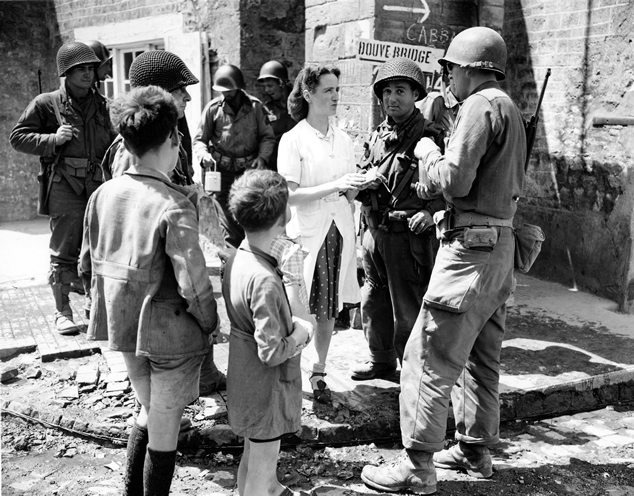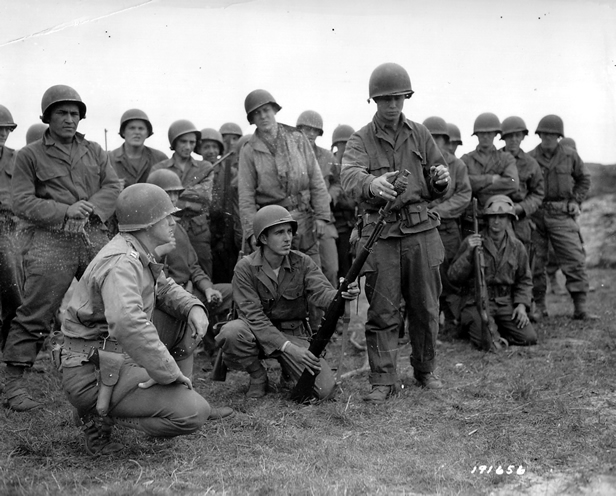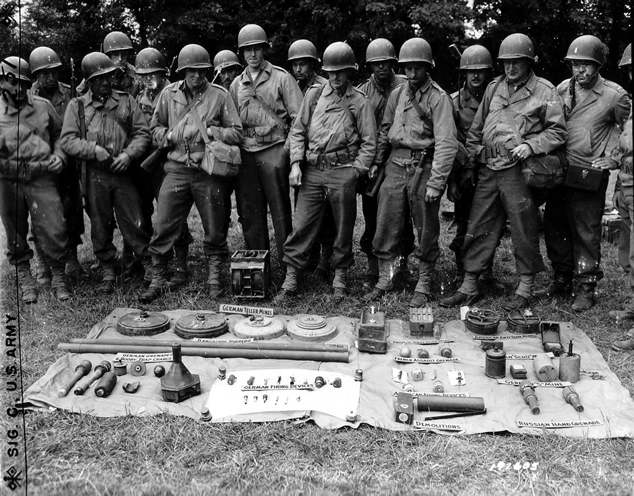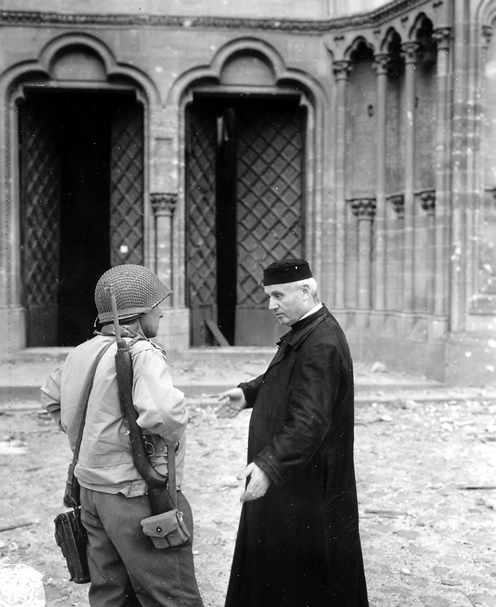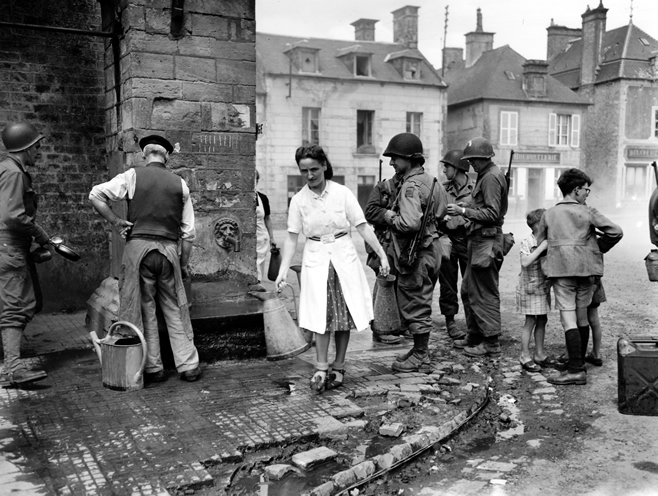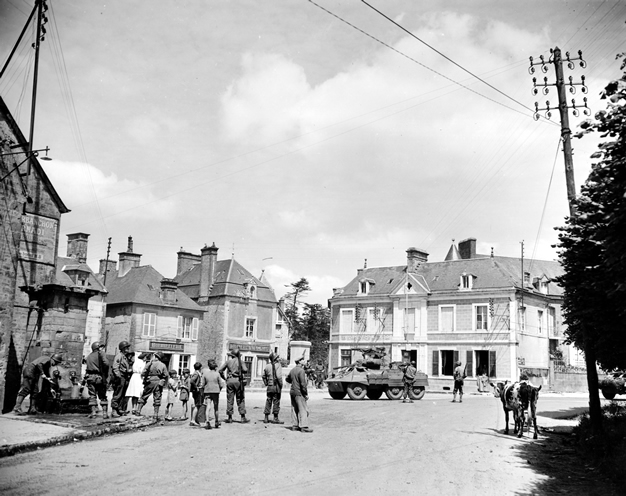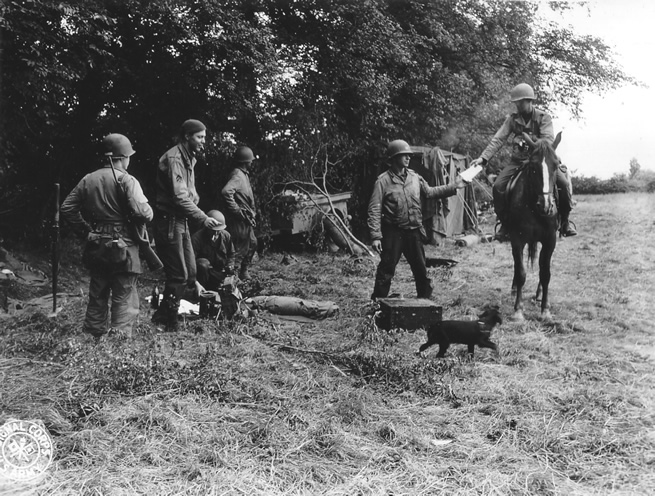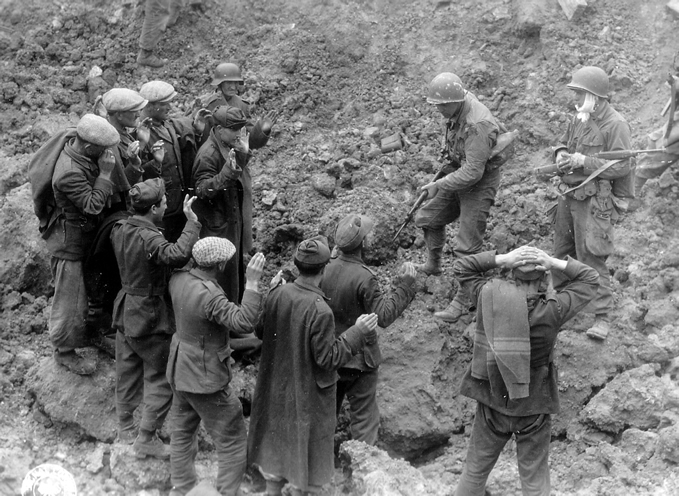The M1 Carbine in Normandy: A Case Study
Date Written: Winter 2009
Author: Chris Guska
Research Assistance: P.W. Browning, Mike "Squirrley" Ellis
From over 2500 photos from the Normandie Archive , I selected 90 photos where carbines were visible of a cross-section of the troops in Normandy.
Source Photographs used in the Study
Not all of the photos are of front line combat troops but rather a representative cross section across all branches and roles. I selected several data points of key interest to reenactors to capture.
1.) Overall Configuration, consisting of Rear Sight type, Stock Type, Front Band type.
2.) Buttstock pouch usage
3.) Total number of pouches carried
4.) Usage of M36 Suspenders with the Carbine
5.) Carrying the M1911(a1) pistol in addition to the Carbine
6.) Use of the M3 Knife or other knives with the M1 Carbine
Here's the breakdown:
Number of Photos: 90
Number of Carbines Observed: 137
Features:
Number of stocks where the oiler cut was visible: 24
Number of observable I cut stocks: 10
Number of observable Oval cut stocks: 14
All 24 of the stocks where the slide relief cut, Highwood/Lowwood area of the stock that was visible were Highwood stocks.
64 Carbines had their front bands visible. All 64 had type 1 barrel bands.
31 Carbines had their rear sights visible. All 31 had type 1 flip sights.
Pouches:
Number of stocks where the buttstock was observable for a pouch: 84
Number of stocks with pouches: 18
Number of stocks without pouches: 66
Number of soldiers wearing no belt for magazine pouches: 25
Number of soldiers with one magazine pouch on their belt observable: 24
Number of soldiers with two magazine pouches on their belt observable: 17
Number of soldiers where the belt was not observable: 71
By the percentages:
Percentage of stocks where the buttstock was observable for a pouch: 61%
Percentage of stocks without pouches: 48%
Percentage of stocks with pouches: 13%
Percentage of soldiers where the belt was not observable: 52%
Percentage of soldiers wearing no belt for magazine pouches: 18%
Percentage of soldiers with one magazine pouch on their belt observable: 17.5%
Percentage of soldiers with two magazine pouches on their belt observable: 12.5%
Accessories:
Number of soldiers wearing M36 Suspenders: 13
Number of soldiers with both the M1 Carbine and M1911(a1): 4
Number of soldiers with the M3 Knife or other knife visible: 23
By the percentages:
Percentage of soldiers wearing M36 Suspenders: 9.5%
Percentage of soldiers with both the M1 Carbine and M1911(a1): 3%
Percentage of soldiers with the M3 Knife or other knife visible: 20%
Conclusions:
1.) The M1 Carbine in Normandy featured a flip rear sight, type 1 barrel band and most likely a highwood stock.
There is some room for variety between I cut stocks and Oval cut highwood stocks.
By the numbers, 2 out of every 7 stocks should be I cut.
2.) The majority of M1 Carbines in use in Normandy did not have a magazine pouch on the buttstock.
By the photos and numbers, 78% or 7/9 Carbines did NOT have a magazine pouch on the buttstock.
In a best case situation for buttstock pouches assuming that 100% of the photos where the buttstock was visible to determine if there truly was a buttstock pouch, 1/2 of the carbines would have buttstock pouches and 1/2 would not.
On the inverse, if every carbine that the buttstock was not visible on did NOT have a buttstock pouch on it, and the assumption was made that in fact there was no buttstock pouch 87% or 7/8 carbines would NOT have them fitted.
Specifically regarding buttstock pouches and their use by combat infantry post normandy, John Hooper of the 29th division remembers that "For my Carbine, I carried one magazine in the weapon and two in the pouch on my belt. It wasn't until about a month after we had landed that putting the ammunition pouch on the stock of the weapon caught on. A few guys started doing it and then everyone was doing it. It was a convenient way of carrying the pouch, an example of Yankee ingenuity." Excerpt from "US Infantry Weapons in Combat"
3.) It was just as common to see a Soldier in Normandy walking around with his carbine without a pistol belt on as it was seeing him wear 1 magazine pouch. It was more common to see 1 magazine pouch or no belt than 2 magazine pouches being worn.
Howard Gaertner of the 9th Division recalls: "I thought the Carbine was a fine gun. It was reliable and it was a lot lighter than the M1. I carried two magazines in a pouch that fit on the stock and one in the gun. It was enough ammo." Excerpt from "US Infantry Weapons in Combat"
3/8 Soldiers photographed went without even a pistol belt while carrying their carbine. This could lead to several conclusions, not limited to:
1.) They are in a rear area, not expecting a fight, but still required to carry it
2.) Extra magazines were carried in the pockets
3.) Their jobs did not require them to constantly have a belt on with canteen and extra ammunition
The remaining 5/8ths of the troops are divided between the 1/3 that only are visibly carrying one extra ammunition pouch, and the 1/4 that are carrying two ammunition pouches.
4.) M36 suspenders with the Carbine is Over Done by reenactors.
There were some Armored and Airborne troops in the photo set - in a proportion representative to the overall numbers of troops, both combat and rear echelon, involved in the Normandy campaign. Despite this, only 1/10 soldiers in the photo set had M36 suspenders and a M1 Carbine. The vast majority of those with both M36's and a Carbine were Airborne.
5.) Too many reenactors carry both the M1 Carbine and M1911(a1).
Of all the troops with Carbines in the photos, only 4 also had a M1911(a1) in addition to their Carbine. This works out to be 3%, or 1/34. I believe this to be a representative number, especially considering the number of rear area troops, whom the M1 carbine was to be the replacement for the M1911(a1). Few individuals, mainly Officers would have had the opportunity of having both, with some exceptions.
6.) Not everyone who had a M1 Carbine had a M3 knife or other similar type knife.
Based on the photos and numbers, only 20% of troops armed with the Carbine were observed to have M3 knives or other similar fighting knives. I suspect the percentage was higher - probably double, but that still leaves the overall ratio to be less than 1/2.
Photos of Interest:
M8 Grenade Launcher in Action:
Photos 22 and 74 both have a single carbine with Grenade Launcher, M8 affixed. This puts the percentage of use at less than 2%: this is an accessory that can be displayed, but used very sparingly for Normandy impressions. According to 1944 TO&E's, the M8 was to be issued extensively in Headquarters and Heavy Weapons Companies in leiu of the M1 or M7 launcher.Also of note in photo 22 is that the soldier has 2 magazines taped together.
British Made Magazine Pouches:
Photos 2, 32, 39, 40 demonstrate the prevalence of British Made Magazine Pouches within certain units. When the Brit Made pouches show up, they show up in large numbers, photo 32 being a prime example.
Notice the angled pocket flap rather than the "rounded" flap common to US made pouches. There was a USMC pattern quite similar, but in fact these are British Made US Army pouches. Of particular interest is photo 2, where the British Made magazine pouch is being worn on the sling near the butt rather than on the buttstock itself
M1a1 in use by the 90th Division:
Photos 63, 65 show a leg infantryman with an M1a1 carbine AND M36 suspenders. Note that he is NOT Airborne, nor is he Armored - but clearly a member of the 90th Infantry Division. More likely than not, he is a forward observer for the 90th Artillery, which was in direct support of the 82nd AB Division in the first week after the June 6 landing. In gratitude for their outstanding fire support, the 82nd AB gave a dozen M1a1 Carbines to the 90th Artillery.
This is a very ISOLATED and well documented circumstance and instance of regular leg infantry using the M1a1 Carbine. For any old infantryman to carry it would be Farby - especially regular infantry. The specific 90th Artillery impression would need to be portrayed to make this correct, and even then for a limited span of the war.
Wearing a M1928 Cartridge Belt with the M1 Carbine:
Photo 21 and 56: No self respecting reenactor or unit commander would ever let one of their soldiers walk around with a Carbine and a Garand belt... ohh but it happened. It happened in only 2 photos, with 2 soldiers, both of them appear to have just "picked something up" for need of a weapon. It may not be the weapon they were issued, but it’s what they have. Single photos like these aren't enough to base an impression off of, but they are certainly something to think about. Remember, 2 guys out of 135 others with carbines, works out to less than 1.5% or 1 in 69 odds... and for some reason, I think the chances are less than even that.Summary:
I specifically chose to do this photo study on Normandy, as WWII ETO reenacting is extremely Normandy+Breakout focused. Based on the study, I will certainly change my own impression as well as my recommendations towards the rest of the unit. Often we base our individual equipment load outs on "practicality" and "usability" for ourselves with reenactment tacticals in mind, rather than a focus and emphasis on historical trends and evidence.
This photo study has revealed some solid conclusions as well as trends that differ from the prevailing trends and opinions within the reenactment community. Simply put, this isn’t one or two photos illustrating the features of a handful of carbines or that magazine pouches were not overwhelmingly worn on buttstocks, but rather a series of 90, high resolution photographs that demonstrate trends we should examine and emulate.
1.) Carbines in Normandy had Flip Sights, Type 1 bands, and highwood stocks.
2.) Buttstock pouches are over done by reenactors. Less is more.
3.) Carry only 1 or 2 magazine pouches. Less is more.
4.) Unless you're doing Airborne or Armored, don’t wear M36 suspenders with your Carbine. Less is more.
5.) If you're carrying a Carbine, chances are you wouldn’t have had a 45 unless you were an Officer or had some special circumstance. Less is more.
6.) Not everyone who had a Carbine had a M3 knife. Less is more.
If there is one thing to take away: Less is more.
Source:
"Photos Normanide http://www.flickr.com/people/photosnormandie/." Photos Normandie. 2004. Conseil Régional de Basse-Normandie. Oct. 2008 <http://www.archivesnormandie39-45.org/>.
Goodwin, Mark G., and Scott A. Duff. US Infantry Weapons in Combat : Personal Experiences from World War II and Korea. Minneapolis: Scott A. Duff Publications, 2005.
90th IDPG Original Research



